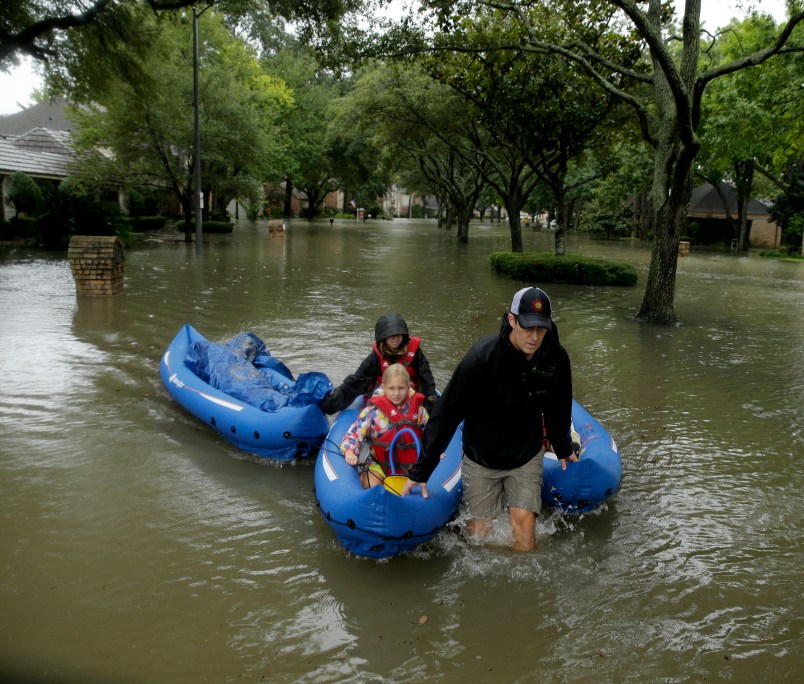HOUSTON (AP) — Floodwaters reached the roof lines of single-story homes Monday and people could be heard pleading for help from inside as Harvey poured rain on the Houston area for a fourth consecutive day after a chaotic weekend of rising water and rescues.
The nation’s fourth-largest city was still largely paralyzed by one of the largest downpours in U.S. history. And there was no relief in sight from the storm that spun into Texas as a Category 4 hurricane, then parked itself over the Gulf Coast. With nearly 2 more feet of rain expected, authorities worried whether the worst was yet to come.
Harvey has been blamed for at least two confirmed deaths. A Houston television station reported Monday that six family members were believed to have drowned when their van was swept away by floodwaters.
The KHOU report was attributed to three family members the station did not identify. No bodies have been recovered.
Police Chief Art Acevedo told The Associated Press that he had no information about the report but said that he’s “really worried about how many bodies we’re going to find.”
According to the station, four children and their grandparents were feared dead after the van hit high water Sunday when crossing a bridge in the Greens Bayou area.
The driver of the vehicle, the children’s great-uncle, reportedly escaped before the van sank by grabbing a tree limb. He told the children to try to escape through the back door, but they were unable to get out.
The disaster unfolded on an epic scale in one of America’s most sprawling metropolitan centers. The Houston metro area covers about 10,000 square miles, an area slightly bigger than New Jersey. It’s crisscrossed by about 1,700 miles of channels, creeks and bayous that drain into the Gulf of Mexico, about 50 miles to the southeast from downtown.
The flooding was so widespread that the levels of city waterways have either equaled or surpassed those of Tropical Storm Allison from 2001, and no major highway has been spared some overflow.
The city’s normally bustling business district was virtually deserted Monday, with emergency vehicles making up most of the traffic. Most traffic signals were out and most businesses closed.
Elsewhere, water gushed from two reservoirs overwhelmed by Harvey as officials sought to release pressure on a pair of dams where floodwaters were at risk of spilling around the sides of the barriers. The move aimed at protecting the downtown business district risked flooding thousands more homes.
Meanwhile, rescuers continued plucking people from the floodwaters — at least 2,000 so far, according to Acevedo. At least 185 critical rescue requests were still pending on Monday morning, he said.
Rescuers were giving priority to life-and-death situations, leaving many people to fend for themselves.
Chris Thorn was among the many volunteers still helping with the mass evacuation that began Sunday. He drove with a buddy from the Dallas area with their flat-bottom hunting boat to pull strangers out of the water.
“I couldn’t sit at home and watch it on TV and do nothing since I have a boat and all the tools to help,” he said.
They got to Spring, Texas, where Cypress Creek had breached Interstate 45 and went to work, helping people out of a gated community near the creek.
“It’s never flooded here,” resident Lane Cross said from the front of Thorn’s boat, holding his brown dog, Max. “I don’t even have flood insurance.”
Houston’s 911 system has received 75,000 calls since Harvey inundated the city, including 20,000 just since late Sunday. The city normally averages 8,000 to 9,000 calls per day.
The Red Cross quickly set up Houston’s George R. Brown Convention Center and other venues as shelters. The center, which was also used as a shelter for Katrina refugees in 2005, can accommodate roughly 5,000 people. By Monday morning, it was already half full.
People living near Houston’s Addicks and Barker reservoirs were warned Sunday that a controlled release would cause additional street flooding that could spill into homes. The rising water and ongoing rain put pressure on a pair of dams that were created to prevent flooding in downtown Houston. If the pressure is not relieved, officials said, it could allow water to spill outside the dams.
Harris and Fort Bend county officials advised residents to pack their cars Sunday night and leave in the morning.
The Army Corps of Engineers started the reservoir releases before 2 a.m. Monday — ahead of schedule — because water levels were increasing at a rate of more than 6 inches (15 centimeters) per hour, Corps spokesman Jay Townsend said.
In the Cypress Forest Estates neighborhood in northern Harris County, people called for help from inside homes as water from a nearby creek climbed to the same level as their eaves. A steady procession of rescue boats floated into the area.
One man, Joe Garcia, carried his German shepherd in the chest-deep water before being picked up by a boat. Garcia said he floated out a tub of his belongings, then went back in for the dog.
Up to 20 more inches (51 centimeters) of rain could fall in the coming days, on top of the more than 30 inches (76 centimeters) some places have already seen, National Weather Service Director Louis Uccellini said Monday.
That means the flooding will get worse in the days ahead and that the floodwaters will be slow to recede once Harvey finally moves on, the weather service said.
The amount of water was so unprecedented that meteorologists had to update the color charts on the weather service’s official rainfall maps.
In Washington, President Donald Trump’s administration assured Congress that the $3 billion balance in FEMA’s disaster fund was enough to handle immediate needs, such as debris removal and temporary shelter for thousands of displaced residents. When lawmakers return next week, a multibillion-dollar aid package is likely to be added to their already packed agenda.
Trump planned to visit Texas on Tuesday, accompanied by first lady Melania Trump.
Harvey was the fiercest hurricane to hit the U.S. in 13 years and the strongest to strike Texas since 1961’s Hurricane Carla, the most powerful Texas hurricane on record.



